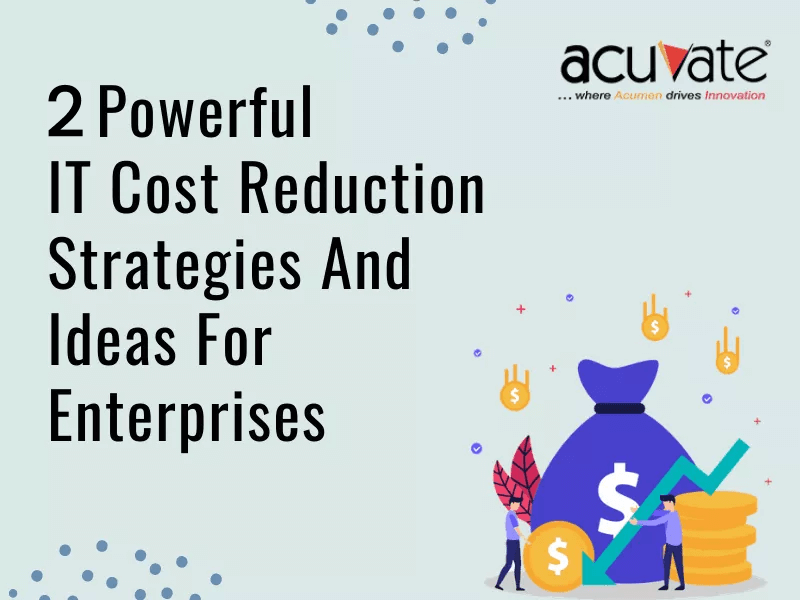In addition to changing the way organizations do business, the COVID-19 pandemic has taught leaders a strategic lesson, “you can’t cut your way to growth, but you can always cut your way to survival.”
As the pandemic transformed how people spend money, businesses, particularly hotels, airlines, and cinemas, had no choice but to cut costs. Companies are now working towards adapting to the “new normal” and shifting direction to accommodate the ups and downs in demand.
In this aspect, investments in digital transformation are helping organizations “stay ahead of the curve” while building a framework for cost optimization, agility, and organizational change. While COVID-19 accelerates the digitization speed, leaders must also prioritize transformation initiatives and allocate resources effectively to reduce wasteful IT spending.
Since cost optimization is one aspect that every organization looks for, here are a few powerful IT cost reduction strategies and ideas for enterprises.
How can organizations reduce IT Costs?
1. Cost reduction through AIOps
As businesses deepen their digital journey and the demand for digital products and services soars to greater heights, organizations must deal with an increasingly complex IT infrastructure. Companies are now operating in a highly dynamic and componentized IT environment that includes new architectures, such as containers, microservices, and multi-cloud and edge computing.
To keep up with these advancements, IT teams must grow at the pace necessary to fill the gap between tasks to be done and people to perform them. As such, complex IT infrastructures call for automation of tasks, like resetting passwords, solving routine queries, completing logs, audits, etc., that are manually intensive to help drive cost efficiencies.
Moreover, data is siloed and isolated by criteria, like business line, business function, data type, etc., resulting in a splintered view incapable of being analyzed as a whole. Artificial intelligence in IT operations, commonly known as AIOps, leverages machine learning and advanced analytics and brings together structured and unstructured data from different applications, repositories, and services to find trends that help predict outages and network downtime.
Downtime affects the entire business operations, leading to a loss in revenue, customer dissatisfaction, and brand damage. AIOps correlates disparate data and derives insights that diagnose and resolve the issue faster, resulting in dramatically reduced costs. Additionally, predictive analytics uses machine learning algorithms to study past incidents and identify trends that are signs of an imminent outage.
2. Cloud Cost Optimization
With cloud services offering unlimited scalability, more organizations are moving towards hosting their resources on the cloud. Therefore, enterprises are looking at ways to optimize cloud costs.
Cloud cost optimization is the process of reducing your overall cloud costs by identifying mismanaged resources, reserving capacity to secure higher discounts, eliminating waste, and “right-sizing” services. Therefore, the best ways to optimize these costs include the following –
● Look for unused resources
The easiest way to optimize cloud costs is to identify and remove unused resources. For example, the admin might take up a temporary server but may forget to turn it off when the task is completed. Or he/she may fail to remove storage attached to jobs they terminate. In any case, an organization’s cloud services bills will include charges for resources they once purchased but no longer use and can be reduced to this extent.
● Optimizing Virtual Machine (VM) costs
A virtual machine is the emulation of a physical computer. In the case of Azure cloud, storage capacity and computing power are the two criteria that decide the virtual machine’s cost. For optimal usage of VMs and to save costs, organizations must operate virtual machines at their full capacity, which can be checked on the Azure monitor metrics.
● Find the right resource size
Cloud service providers, such as Azure, offer a large number of options to account for different requirements, including more RAM, more CPU, etc. To avoid oversizing the system’s requirements and save costs, organizations must let the cloud optimization tool monitor the conditions and notify the need to downscale, rightsize, or cut down on a resource.
● Consolidate idle resources
An idle computing resource runs at a CPU utilization level of 1-5%. When an organization is billed at 100% for an idle instance, it is an unnecessary expense that must be eliminated. By identifying and consolidating such instances into fewer groups, organizations can cut wasteful costs. Moreover, since the cloud offers on-demand scaling and load balancing, organizations can scale up or down as needed.
● Shifting from virtual machines to containers
In addition to virtual machines, Azure offers containers as a computing option, which provides benefits in terms of faster operability and lower footprint. Azure Kubernetes Service (AKS) is a container hosting platform that combines different tasks in fewer servers. Other features include built-in monitoring, role-based access control (RBAC), wizard-based resource management, and active directory integration.
● Shifting from virtual machines to containers
While IT service desk agents are immersed in maintaining IT tickets, including resolving incidents, solving routine problems, and managing service requests, projects that improve productivity and add business value get ignored.
Enterprise virtual assistants (EVA) use AI, ML, and NLP to enable easy, real-time, 24X7, intelligent IT support for exceptional service. Their ability to cater to day-to-day service requests, such as resetting passwords, answering FAQs, providing smart suggestions, and executing automated remediations specific to a user’s role, location, persona, etc., enable organizations to minimize human intervention without compromising on quality.
Since IT service management is a labor-intensive department, triaging service requests and automating routine tasks through EVA saves huge costs and enables the IT staff to focus on business growth initiatives.
How Acuvate can help reduce your IT costs
As highlighted above, Acuvate’s AI-driven managed services (AiDMS) helps organizations reduce service desk costs, automate ITOps, optimize cloud spending, and enhance IT operations through a mix of analytics and machine learning. Key components of our service include – (i) AIOps, (ii) Azure Cost Optimization, and (iii) AI-powered Virtual Assistants.
Moreover, our quick and intuitive AiDMS ROI calculator estimates the potential cost savings and the net ROI that our managed services can bring to your organization.



